The Legend of Bucephalus
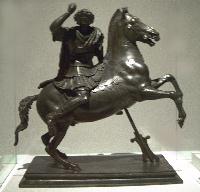
Few horses have captured the imagination like Alexander's horse Bucephalus. Though not much is known about him, we do know he was a dark stallion, somewhat temperamental. Though he is described as black, it is likely he was the more common standard bay, which is usually described as "black". And though most people imagine a tall stallion, the truth is probably somewhat less grand.
Breeding Stock
The best breeding of Greek horse stock took place in Thessaly, where prime existing stock was often crossed with Scythian, Persian (Nisean) and Ferghana horses. Philip of Makedon (who built on-going cavalry developments enough to be considered by many to be responsible for developing the cavalry as an effective fighting unit) is said to have imported 20.000 Scythian mares to Makedon. His son, Alexander, claimed a tribute of 50.000 Persian horses, which continued the infusion of Scythian, Nisean, Jaf, Ferghana and possibly Caspian and other blood into the Makedonian horses. Since the Persian Arab is thought to have been introduced into Persia around 2000 BC, it is likely that this bloodline was included.
Few of these horses were tall by modern standards, averaging 13.2 - 14.2 hands, with the possible exception of the Ferghana crosses and some of the Iberian stock. We know that the Iberian horses mentioned by Homer were famed for their movement, size and spirit; the Nisean horses were known for speed and stamina, the Ferghana was noted for stamina, endurance and the ability to withstand hard conditions in desert lands. Along with imported stock, Philip had access to the native breeds such as the Pindos, Skyros, Pineias, Messara and Andravidas, horses known to be small but tough. Looking at the stock Philip used in breeding programs, one can easily imagine a hardy horse with stamina, endurance and longevity. It was from these bloodlines that Bucephalus may have been bred, in the fertile pastures of Thessaly.
Thessaly offered rich pasture lands, excellent for raising all types of grazers. Athenian archives reveal many brands indicating horse-rearing areas. Pherae horses carried an ax brand; Larissan horses were branded with a centaur. Pharsalus horses, noted for their quality since the days of Aristophanes (c.450-c.383), were branded with an ox head, or *boukephalus.* It is also claimed that the name Bucephalus was also ascribed to those horses with an unusual naturally occurring feature, a peculiar shaped white mark on their forehead (Kroll, 'Archive of the Athenian Cavalry', p.88).
Though no one knows the truth about Bucephalus' breeding or raising, Pseudo-Callisthenes presents a mythic variant of Bucephalus' origin. In this tale, Philip is presented with a colt bred on his own estates, the heroic attributes of the animal surpasses Pegasus. The mythic attributes of the animal are further reinforced by the Delphic Oracle, which tells Philip that the destined king of the world will be the one who rides Bucephalus, a horse with the mark of the ox's head on his haunch.
It is quite likely that Bucephalus was bred on one of the many farms that formed part of the Makedonian breeding program. His quality would have been obvious from the start. However, many of the breeds used in these programs were described as temperamental and would have represented a challenge to train, especially since training methods varied widely from the excellent to the poor.
As much as Alexander was bathed in legend, Bucephalus, too, took on mythic proportions. One can picture this lord among horses, with his held high, dock horizontal and his tail curved upward, his wavy mane floating up and down with every prancing gate, as the other horses gave ground, instinctively knowing this stallion was destined to be king of all domains. Makedonian royals were good judges of horseflesh. Overlooking the herd, Philip and Alexander couldn't help but notice the dark horse. Even the price of this animal was unusual: at either 13 talents (Plutarch) or 16 talents (Pliny the Elder), the cost alone would have represented a great value, as the Attic weight to a talent was approximately 57 to 60 lbs of gold or silver.
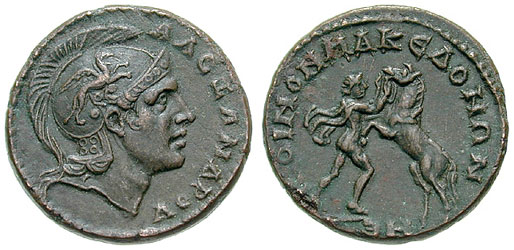 Philip ordered his attendants to mount Bucephalus but as each and every attendant attempted to mount him, Bucephalus would spin, resist, and attack, especially when his back was to the sun. Eventually all those who attempted to mount Bucephalus had been thrown off. Horsemen know that most horses, left alone and un-worked for long periods of time, could appear to have become un-manageable. The average rider can be deceived into losing control, achieving nothing with the horse or themselves. But horses, equipped with a different but high level of intelligence, generally favor handlers with gentle common "horse sense". Bucephalus was no exception- coming from well-bred but intelligent stock, he would have need not only good training but a rider of equal intelligence and skill. It may be that Bucephalus had lacked proper training, it may be that he did not feel trust towards those trying to ride him (horses have an lnstinct for knowing when a person can ride or not). But legend says the magnificent horse felt confused and afraid of his shadow. Maybe Philonicus was hoping for a cloudy day; if so, he didn't get it!
Philip ordered his attendants to mount Bucephalus but as each and every attendant attempted to mount him, Bucephalus would spin, resist, and attack, especially when his back was to the sun. Eventually all those who attempted to mount Bucephalus had been thrown off. Horsemen know that most horses, left alone and un-worked for long periods of time, could appear to have become un-manageable. The average rider can be deceived into losing control, achieving nothing with the horse or themselves. But horses, equipped with a different but high level of intelligence, generally favor handlers with gentle common "horse sense". Bucephalus was no exception- coming from well-bred but intelligent stock, he would have need not only good training but a rider of equal intelligence and skill. It may be that Bucephalus had lacked proper training, it may be that he did not feel trust towards those trying to ride him (horses have an lnstinct for knowing when a person can ride or not). But legend says the magnificent horse felt confused and afraid of his shadow. Maybe Philonicus was hoping for a cloudy day; if so, he didn't get it!
Philip could not see paying such a price for an unruly horse and ordered the horse taken away. According to legend, Alexander called out that it was a shame to waste such an animal because of poor riders. One can imagine that day:
Philip turned to look at his son. "Alexander, whatever do you mean?"
"I can tame this horse to ride," Alexander replied. "It only needs the right rider".
Philip scoffed "My attendants have been working with horses most of their lives, but you know better?" Alexander nodded, his mouth setting into stubborn lines.
"I know it would be shameful to throw away a good horse because people haven't been paying attention to the sort of animal he is." Alexander had realized that the stallion was nervous, unsure of his handlers, trusting no one but himself. He was also an animal filled with pride and a sense of self-awareness unusual for his kind. Pausing for just a moment, Alexander said with confidence " I know this horse and I'll make a wager for the price of the horse that I can ride him".
 Philip reluctantly agreed, thinking that Alexander would be humbled and think more carefully of future bets. At the same time, he admired the fire in the boy and didn't want to quench it. He watched as Alexander slowly approached Bucephalus and carefully took the bridle below the chin. Alexander knew a frightened horse will jerk his head away and he wanted to be certain the animal could feel Alexander's own confidence. He gently stroked the center of Bucephalus' nose and lips with his finger Remembering a horse can kick a fly off its ears, Alexander calmly moved towards the stifle, placing his other hand on the horses body, rubbing and scratching the horse's flank, moving forward with his hand to slowly massage the neck top-line.
Philip reluctantly agreed, thinking that Alexander would be humbled and think more carefully of future bets. At the same time, he admired the fire in the boy and didn't want to quench it. He watched as Alexander slowly approached Bucephalus and carefully took the bridle below the chin. Alexander knew a frightened horse will jerk his head away and he wanted to be certain the animal could feel Alexander's own confidence. He gently stroked the center of Bucephalus' nose and lips with his finger Remembering a horse can kick a fly off its ears, Alexander calmly moved towards the stifle, placing his other hand on the horses body, rubbing and scratching the horse's flank, moving forward with his hand to slowly massage the neck top-line.
Horse Whispering
Alexander knew horses notice hand and head motions and respond quickly; he knew that because horses are not a verbal animal, words were unnecessary to gain a response from the horse. (In the future, modern parlance would call this form of training "horse whispering" or natural training). Alexander knew that horses, as a prey animal, often feared shadows so he led him by the reins in all directions, touching him gently, whispering comforting sounds, letting the horse see the movement of sun and shadow, learning there was nothing to fear in this strange field, surrounded by unknown strangers.
Slowly, Alexander eased onto the horses back. The animal stood, alert but calm, turning his ears back in an attempt to understand this confident boy on his back. Alexander worked the reins and leg pressure just enough to take his horse from a trot to a canter as everyone held their breath. He gave the horse more rein, allowing Bucephalus to move into a gallop. Keeping the horse's head up, he urged him with his heel and leg pressure into a full run After working the horse for a while in view of an ever-growing audience, Alexander stopped Bucephalus in front of Philip. A cheering crowd surrounded father, horse and son. With tears of laughter and joy, pride showing in his very gesture, Philip said "Alexander my son, Macedon is too small- You need to find another kingdom worthy of you!" And thus began the legend.
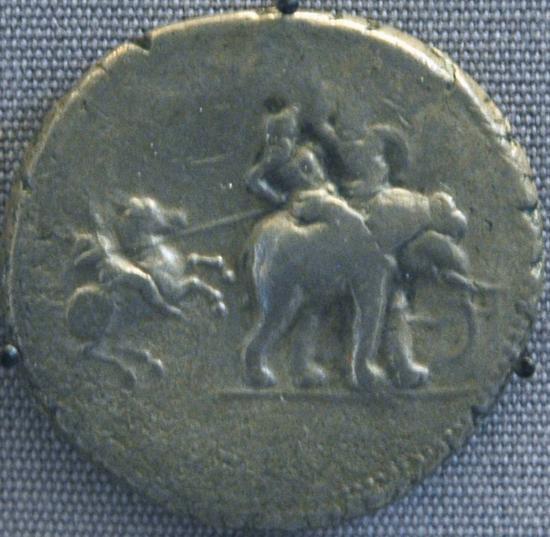 As one of his chargers, Alexander rode Bucephalus in many battles. The legend of Alexander's magnificent horse struck many an artists imagination, from the ancient world to the modern. Paintings of Labrum's Alexander subjects survive in the Louvre Museum. One in particular, The Passage of the Granicus, depicts the warhorse contesting the difficulties of the steep muddy river banks, biting and kicking all foes. Whether depicted as black, white, large or small, there is something about this horse that strikes a responsive chord in even the most jaded viewer.
As one of his chargers, Alexander rode Bucephalus in many battles. The legend of Alexander's magnificent horse struck many an artists imagination, from the ancient world to the modern. Paintings of Labrum's Alexander subjects survive in the Louvre Museum. One in particular, The Passage of the Granicus, depicts the warhorse contesting the difficulties of the steep muddy river banks, biting and kicking all foes. Whether depicted as black, white, large or small, there is something about this horse that strikes a responsive chord in even the most jaded viewer.
Longevity was not the norm for the ancient chargers. Mortality rate was high due to extreme climate changes without time to adapt, severe hoof bruising from sharp rocks and bad splits without proper time to heal. Battle wounds and exhaustion were primary killers. But even in this, Bucephalus reached beyond other horses. Arrian states Bucephalus died sometime between the age of 28 to 30, a good age even by modern standards for pampered, well-tended horses. This would have placed Bucephalus a comparable age with Alexander when they first met. Some have questioned why Philonicus would bring a mid-age horse to Philip with a high price, but this discounts that many mid-age horses are preferred due to their proven ability to withstand hardship and the fact that their past experiences usually make them less likely to be flighty. It may also be that Bucephalus had proven himself a sire of quality horses and Philonicus may well have believed Philip would be willing to pay for an infusion of proven bloodlines.
Others debate that Bucephalus was of a younger age and died of severe battle wounds he received at the Battle of the River Hydaspes, 326 BCE. What is known, however, is that Alexander gave him a state funeral and founded a new city, Bucephala (now modern day Jhelum/Djemoul) in Bucephalus' honor.
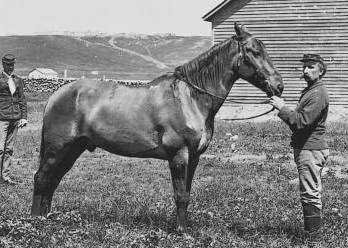 Another charger that can be compared to Bucephalus was Comanche, the only survivor from the Battle of the little Big Horn, who survived his wounds and lived a long life. Comanche was owned by Capt. Myles Keough, this is the story of his last battle;
Another charger that can be compared to Bucephalus was Comanche, the only survivor from the Battle of the little Big Horn, who survived his wounds and lived a long life. Comanche was owned by Capt. Myles Keough, this is the story of his last battle;
Comanche remained with his owner on Custer Hill. Evidence and oral tradition shows that all the other soldiers slaughtered their horses for cover except for Keogh who crouched between Comanche’s legs fighting and holding onto his reins. When Keogh was killed, his one hand remained clutched to Comanche’s reins. Shot with seven arrows, Comanche stood proud over his friend as the warriors were overwhelmed with sudden strong emotion that a man was so close to his horse as he held the reins even in death; because of the thought of bad medicine the warriors left the horse alone and the native Amercian women did not violate the body of Capt. Keogh. Comanche was nursed back to health and lived seventeen years after the Battle of the Little Bighorn as a pampered pet, traveling from post to post and loved by all, he was cherished and revered by the Seventh Cavalry and the entire nation as a symbol of survival in the face of defeat.It is said he developed a fondness for beer in his later years, After his death at the age of twenty nine, he was stuffed and kept on display at the University of Kansas, where he remains to this day.
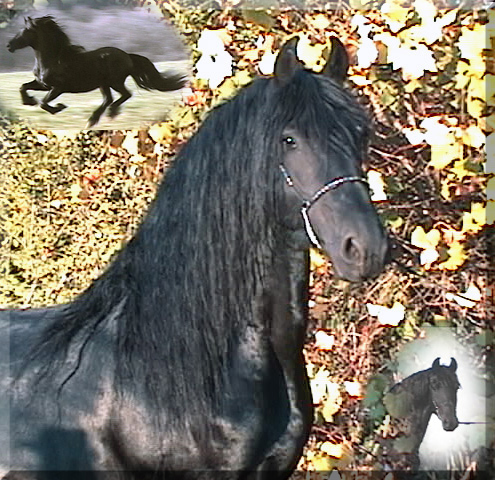 Briefly, the horse used in the Oliver Stone Alexander movie was a Friesian. This breed developed in Friesland as a knight's horse but the breed was "lightened" for trotting races later on. They are still used as cart and carriage horses in Europe for the most part, though the lighter ones are also used in dressage. They are not as fast as some breeds (in the movie and trailers, if you watch closely, you will see many of the other riders reining their horses in so Alexander's horse can be at the front) but they are elegant and have a high-stepping vertical action, which can be easily felt when riding them. A Friesian was also used in the movie "Ladyhawke".
Briefly, the horse used in the Oliver Stone Alexander movie was a Friesian. This breed developed in Friesland as a knight's horse but the breed was "lightened" for trotting races later on. They are still used as cart and carriage horses in Europe for the most part, though the lighter ones are also used in dressage. They are not as fast as some breeds (in the movie and trailers, if you watch closely, you will see many of the other riders reining their horses in so Alexander's horse can be at the front) but they are elegant and have a high-stepping vertical action, which can be easily felt when riding them. A Friesian was also used in the movie "Ladyhawke".
The Dutch registry does not allow (or at least has not) crossbreedings, and the Friesian has remained a "clean" line until recently. Sadly, the German registry began allowing outcrossings in America and there is beginning to be an over-abundance of high-priced crossbreeds there. I predict the American market will flood and in a few years, you will be able to buy them for less at the horse auctions. This is what happened to the Arab breed - and some fantastic bloodlines ended up going for meat in Europe.
In reality, this would not have been the horse of choice for the type of battles Alexander fought (also, they were not in existence in this form at the time).
Notes for Bucephalus; The Horse in the Ancient World by A. Hyland, p.149. Bucephalus' price- Plutarch, (13 talents) Pliny the Elder (16 talents). The story of the horse brought to Pella, Bucephalus died at the age of thirty, in 326 BCE. (Arrian.Ann, B.5.19, p.282;M.M. Morgan in X.Horse.,pp. 101ff; Plutarch, 'Alexander', in The Age of Alexander. Nine Greek Lives, tr. Ian Scott Kilvert (Penguin 1973 (1982), p. 257.6.
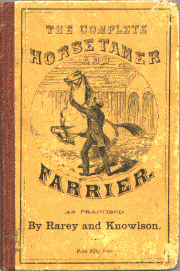
The Original Horse Whisperer's name was John Solomon Rarey. (1827-1866) His book was called; The complete Horse Tamer and Farrier, by Rarey and Knowlson.
Article on the Oliver Stone Movie by Sikander
Written by
Previous page: Animals
Next page: Alexander and Lions
